CHEVROLET CAVALIER 1997 3.G Owners Manual
Manufacturer: CHEVROLET, Model Year: 1997, Model line: CAVALIER, Model: CHEVROLET CAVALIER 1997 3.GPages: 388, PDF Size: 20 MB
Page 191 of 388
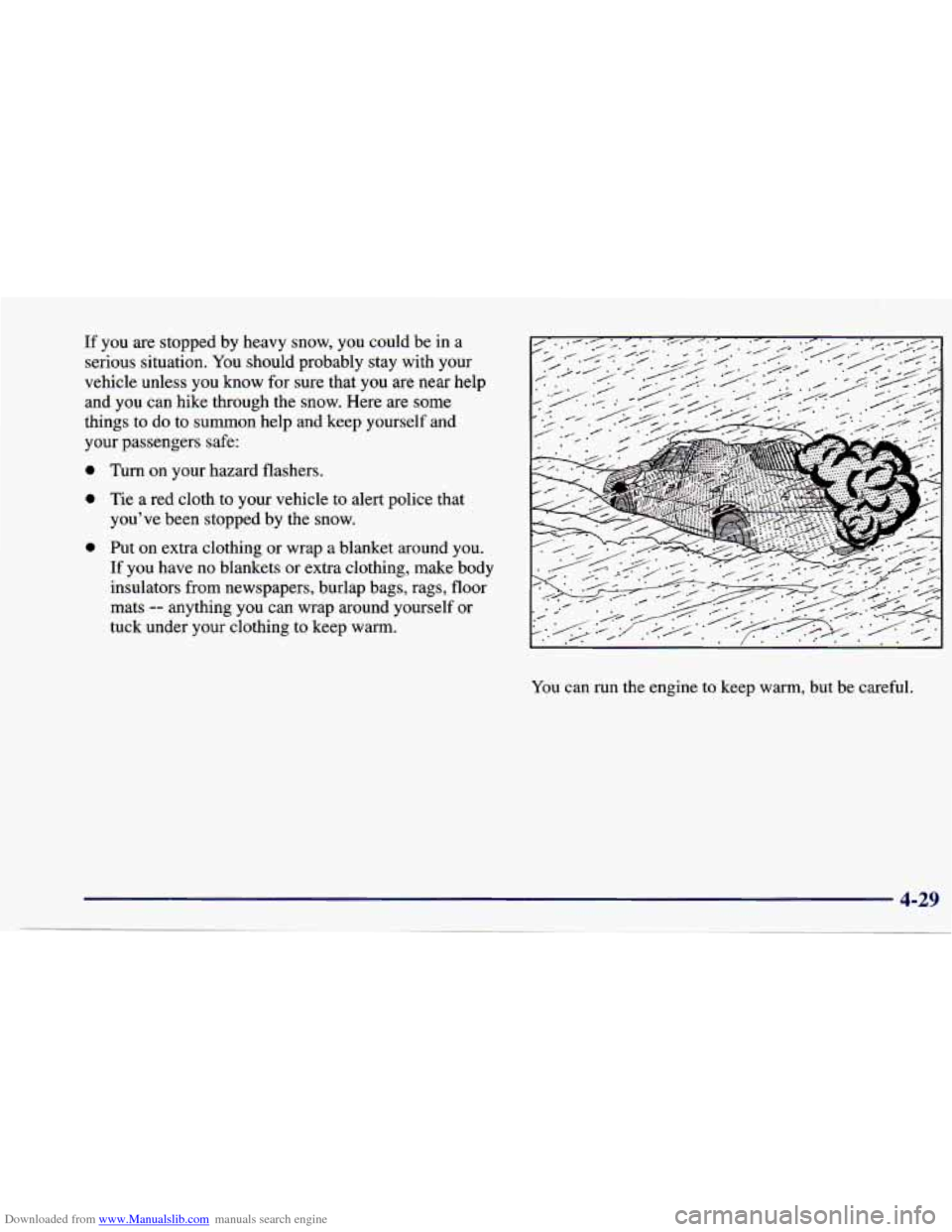
Downloaded from www.Manualslib.com manuals search engine If you are stopped by heavy snow, you could be in a
serious situation.
You should probably stay with your
vehicle unless you know for sure that
you are near help
and you can hike through the snow. Here are some
things to do to summon help and keep yourself and
your passengers safe:
0 Turn on your hazard flashers.
0 Tie a red cloth to your vehicle to alert police that
you’ve been stopped by the snow.
0 Put on extra clothing or wrap a blanket around you.
If you have
no blankets or extra clothing, make body
insulators from newspapers, burlap bags, rags, floor mats
-- anything you can wrap around yourself or
tuck under your clothing to keep warm.
You can run the engine to keep warm, but be careful.
4-2
Page 192 of 388
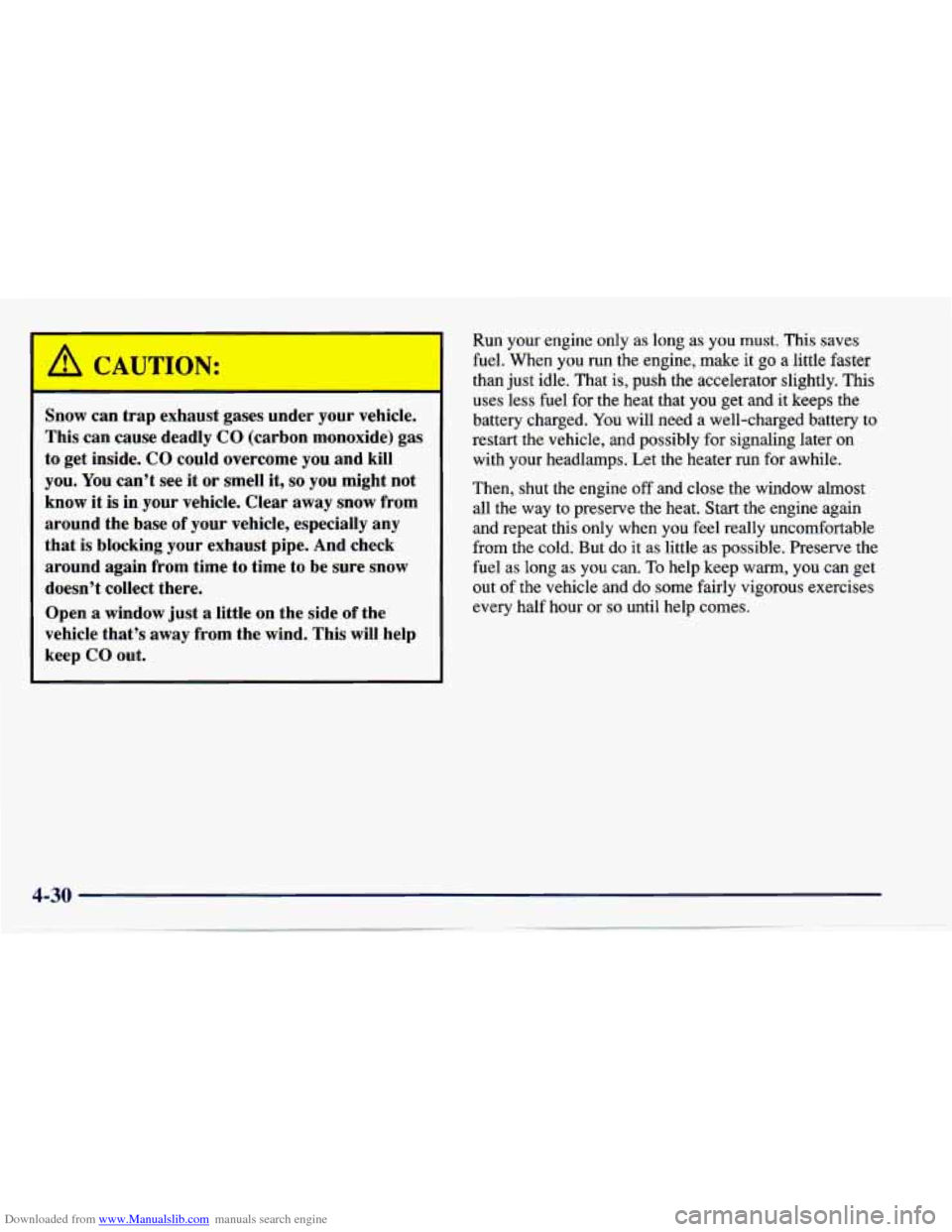
Downloaded from www.Manualslib.com manuals search engine A CAUTIl- N:
Snow can trap exhaust gases under your vehicle.
This can cause deadly
CO (carbon monoxide) gas
to get inside.
CO could overcome you and kill
you. You can’t see it or smell it, so you might not
know it is in your vehicle. Clear away snow from
around the base
of your vehicle, especially any
that is blocking your exhaust pipe. And check
around again from time to time to be sure snow
doesn’t collect there.
Open
a window just a little on the side of the
vehicle that’s away from the wind. This will help
keep
CO out. Run your
engine only as long as
you must. This saves
fuel. When you run the engine, make it go
a little faster
than just idle. That is, push the accelerator slightly. This
uses less fuel for the heat that you get and
it keeps the
battery charged. You will need a well-charged battery to
restart the vehicle, and possibly for signaling later on
with
your headlamps. Let the heater run for awhile.
Then,
shut the engine off and close the window almost
all the way to preserve the heat. Start the engine again
and repeat this only when you feel really uncomfortable
from the cold. But do it
as little as possible. Preserve the
fuel
as long as you can. To help keep warm, you can get
out of the vehicle and
do some fairly vigorous exercises
every half hour or
so until help comes.
Page 193 of 388
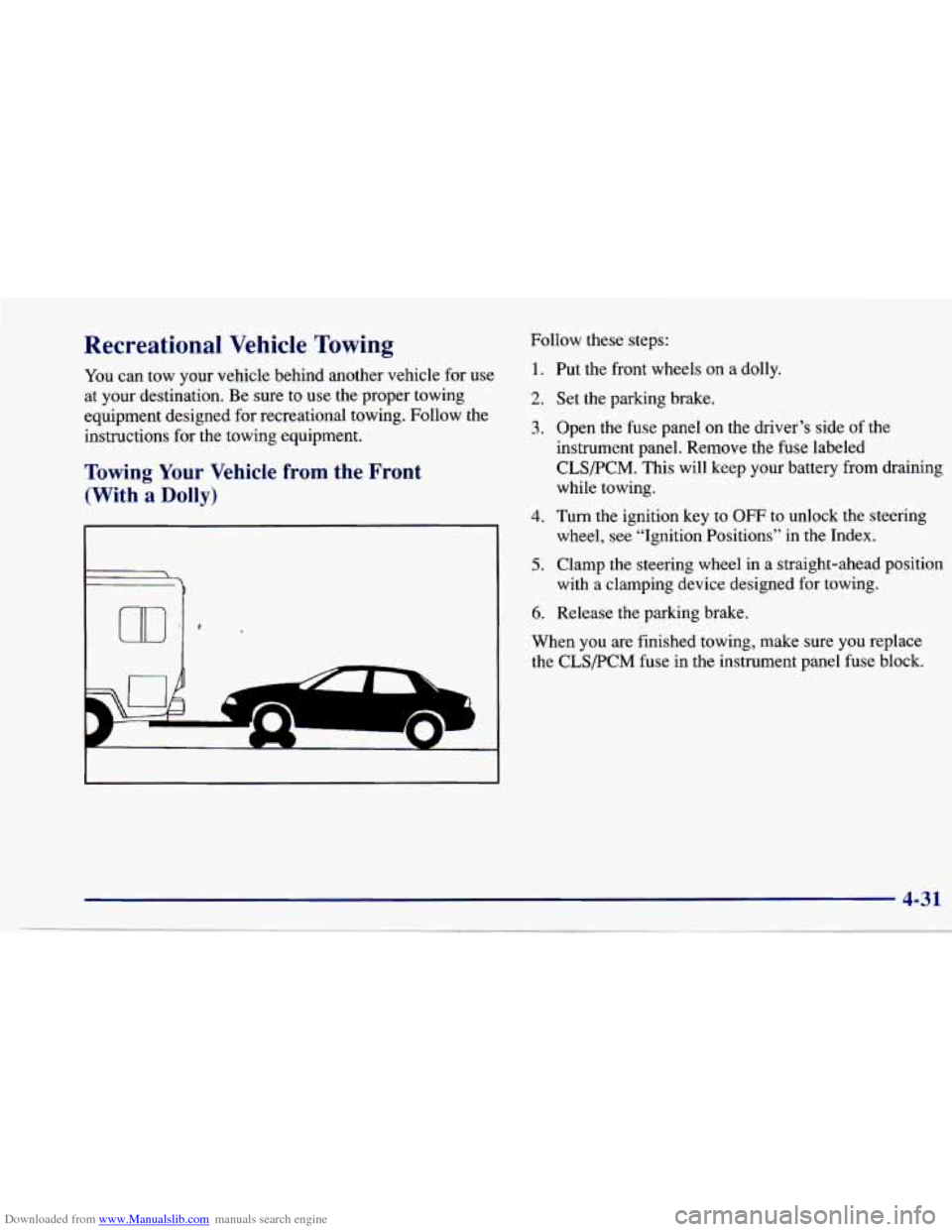
Downloaded from www.Manualslib.com manuals search engine Recreational Vehicle Towing
You can tow your vehicle behind another vehicle for use
at your destination. Be sure to use the proper towing
equipment designed for recreational towing. Follow the
instructions for the towing equipment.
Towing Your Vehicle from the Front
(With a Dolly)
ml
Follow these steps:
1.
2.
3.
4.
5.
6.
Put the front wheels on a dolly.
Set the parking brake.
Open the
fuse Dane1 on the driver’s side o f the I I
instrument panel. Remove the fuse labeled
CLS/PCM. This will keep
your battery from draining
while towing.
Turn the ignition key
to OW to unlock the steering
wheel, see “Ignition Positions” in the Index.
Clamp the steering wheel in a straight-ahead position
with a clamping device designed for towing.
Release the parking brake.
When
you are finished towing, make sure you replace
the CLS/PCM fuse in the instrument panel fuse block.
Page 194 of 388
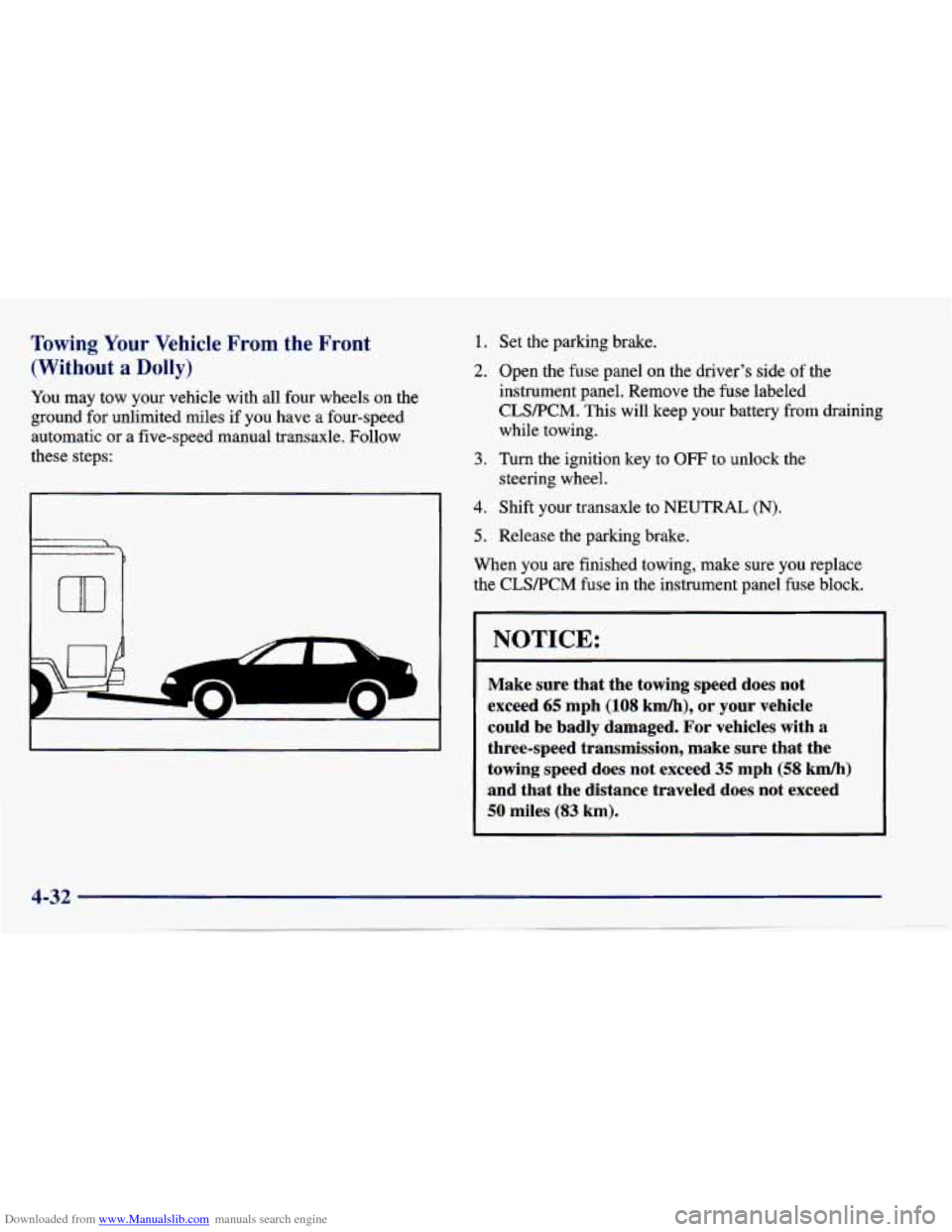
Downloaded from www.Manualslib.com manuals search engine Towing Your Vehicle From the Front
(Without
a Dolly)
You may tow your vehicle with all four wheels on the
ground for unlimited miles if you have
a four-speed
automatic or
a five-speed manual transaxle. Follow
these steps:
L
1.
2.
3.
4.
5.
Set the parking brake.
Open the fuse panel on
the driver’s side of the
instrument panel. Remove the fuse labeled
CLSPCM. This will keep your battery from draining
while towing.
Turn the ignition key
to OFF to unlock the
steering wheel.
Shift your transaxle to NEUTRAL
(N).
Release the parking brake.
When you
are finished towing, make sure you replace
the CLSRCM fuse in the instrument panel fuse block.
NOTICE:
Make sure that the towing speed does not
exceed
65 mph (108 kmh), or your vehicle
could be badly damaged. For vehicles with
a
three-speed transmission, make sure that the
towing speed does not exceed
35 mph (58 km/h)
and that the distance traveled does not exceed
50 miles (83 km).
Page 195 of 388
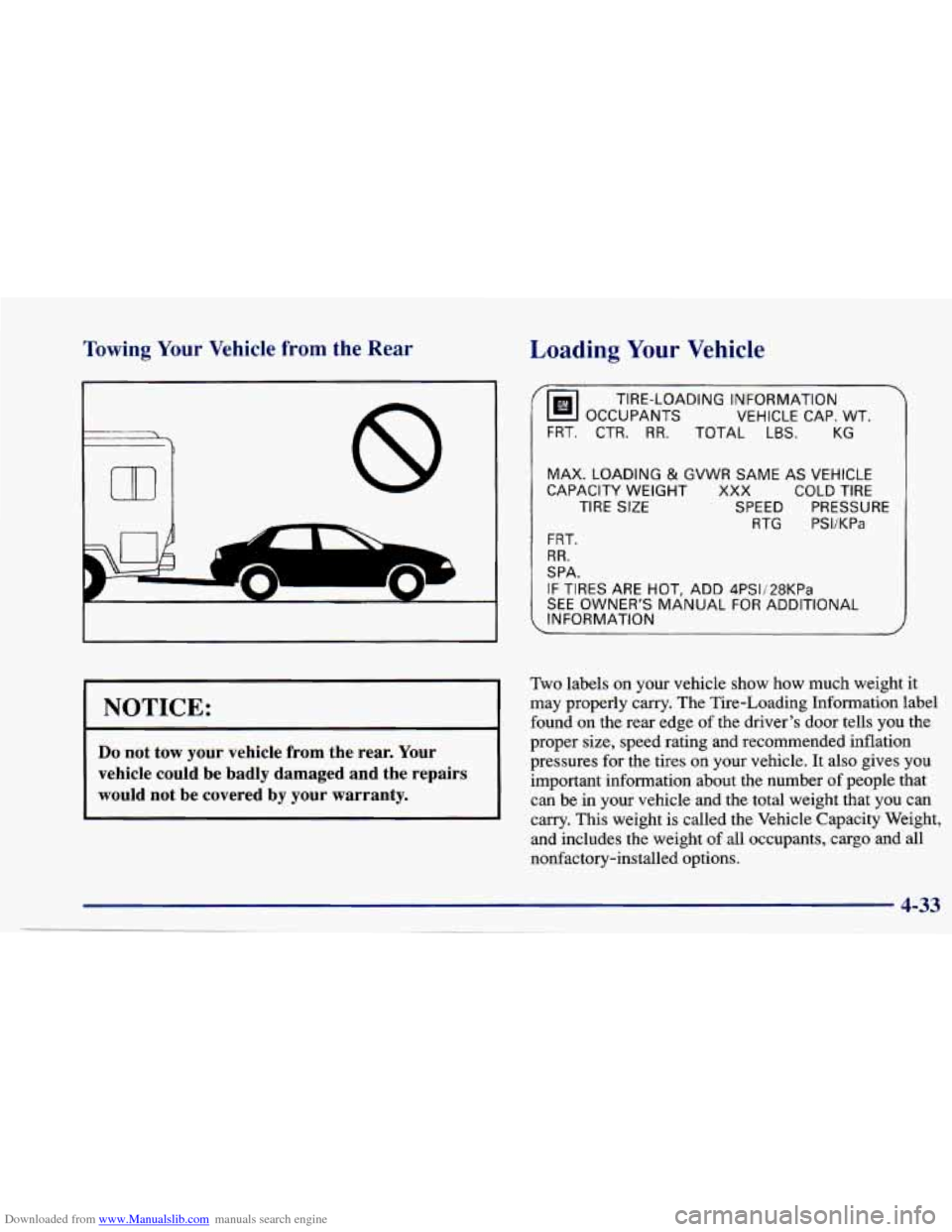
Downloaded from www.Manualslib.com manuals search engine Towing Your Vehicle from the Rear Loading Your Vehicle
I- I
8
‘m OCCUPANTS VEHICLE CAP. WT.
TIRE-LOADING INFORMATION
FRT. CTR.
RR. TOTAL LBS. KG
MAX. LOADING & GVWR SAME AS VEHICLE
CAPACITY WEIGHT XXX
COLD TIRE
TIRE SIZE SPEED PRESSURE
RTG
PSI/KPa
FRT.
RR.
SPA.
IF TIRES ARE HOT, ADD 4PS1/28KPa
SEE OWNER‘S MANUAL FOR ADDITIONAL
INFORMATION
Two labels on your vehicle show how much weight it
found on the rear edge
of the driver’s door tells you the
Do not tow your vehicle from the rear. Your proper size, speed rating and recommended inflation
pressures for the tires on your vehicle. It also gives you
vehicle could be badly damaged and the repairs important information about the number of people that
would not be covered by your warranty. can be in your vehicle and the total weight that you can
carry. This weight is called the Vehicle Capacity Weight,
and includes the weight of all occupants, cargo and all
nonfactory-installed options.
NOTICE: may properly carry. The Tire-Loading Information label
4-33
. ~
Page 196 of 388
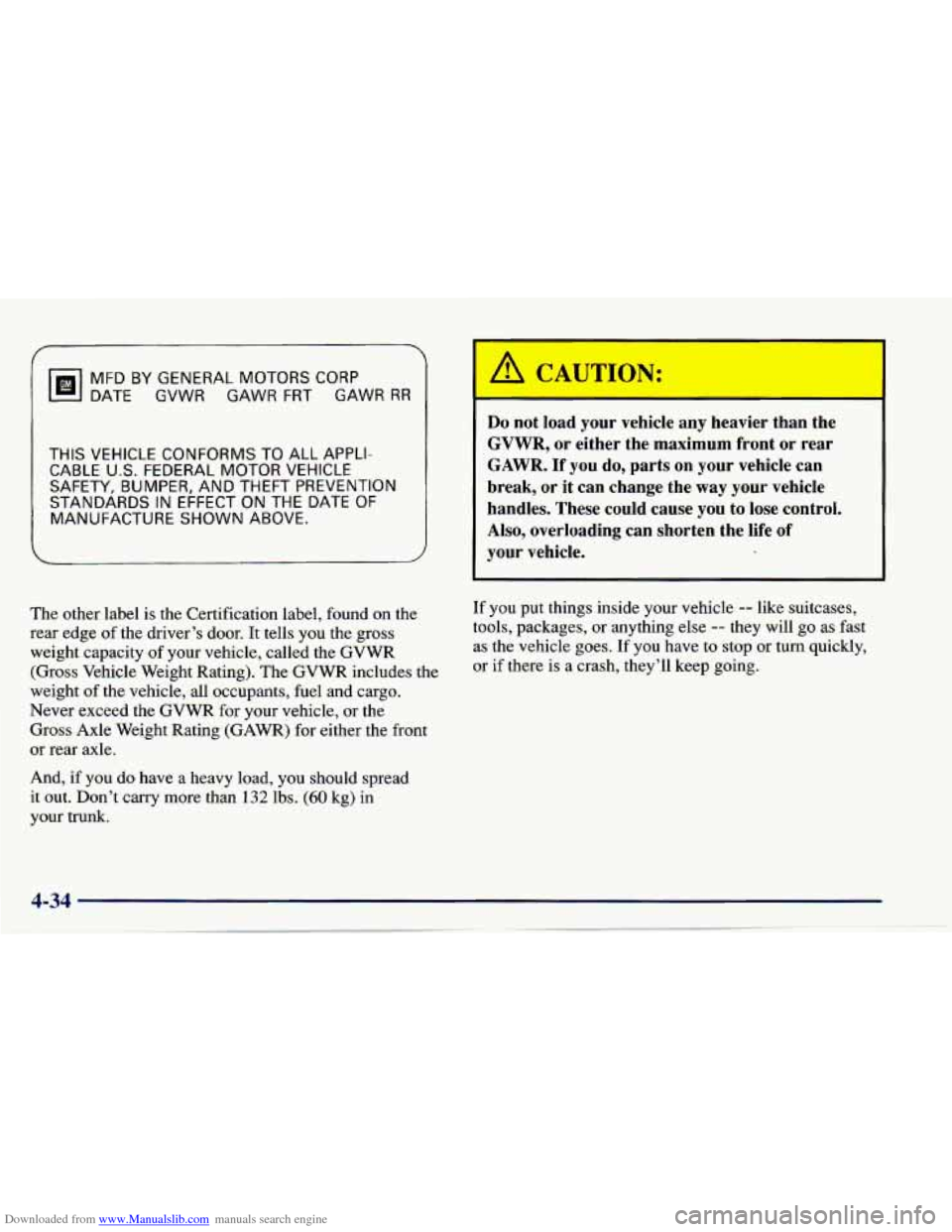
Downloaded from www.Manualslib.com manuals search engine r
MFD BY GENERAL MOTORS CORP
DATE GVWR GAWR FRT GAWR RR
THIS VEHICLE CONFORMS TO ALL APPLI-
CABLE U.S. FEDERAL MOTOR VEHICLE
SAFETY,
BUMPER, AND THEFT PREVENTION
STANDARDS
IN EFFECT ON THE DATE OF
MANUFACTURE SHOWN ABOVE.
The other label is the Certification label, found on the
rear edge of the driver’s door.
It tells you the gross
weight capacity of your vehicle, called the GVWR
(Gross Vehicle Weight Rating).
The GVWR includes the
weight of the vehicle,
all occupants, fuel and cargo.
Never exceed the GVWR for your vehicle, or the
Gross Axle Weight Rating
(GAWR) for either the front
or rear axle.
And, if you
do have a heavy load, you should spread
it out. Don’t carry more than
132 lbs. (60 kg) in
your trunk.
I A CAU’110.k
Do not load your vehicle any heavier than the
GVWR, or either the maximum front or rear
GAWR. If you do, parts on your vehicle can
break, or it can change the way your vehicle
handles. These could cause you
to lose control,
Also, overloading can shorten the life of
your vehicle.
~ ~~
If you put
things inside your vehicle -- like suitcases,
tools, packages, or anything else
-- they will go as fast
as the vehicle goes.
If you have to stop or turn quickly,
or
if there is a crash, they’ll keep going.
Page 197 of 388
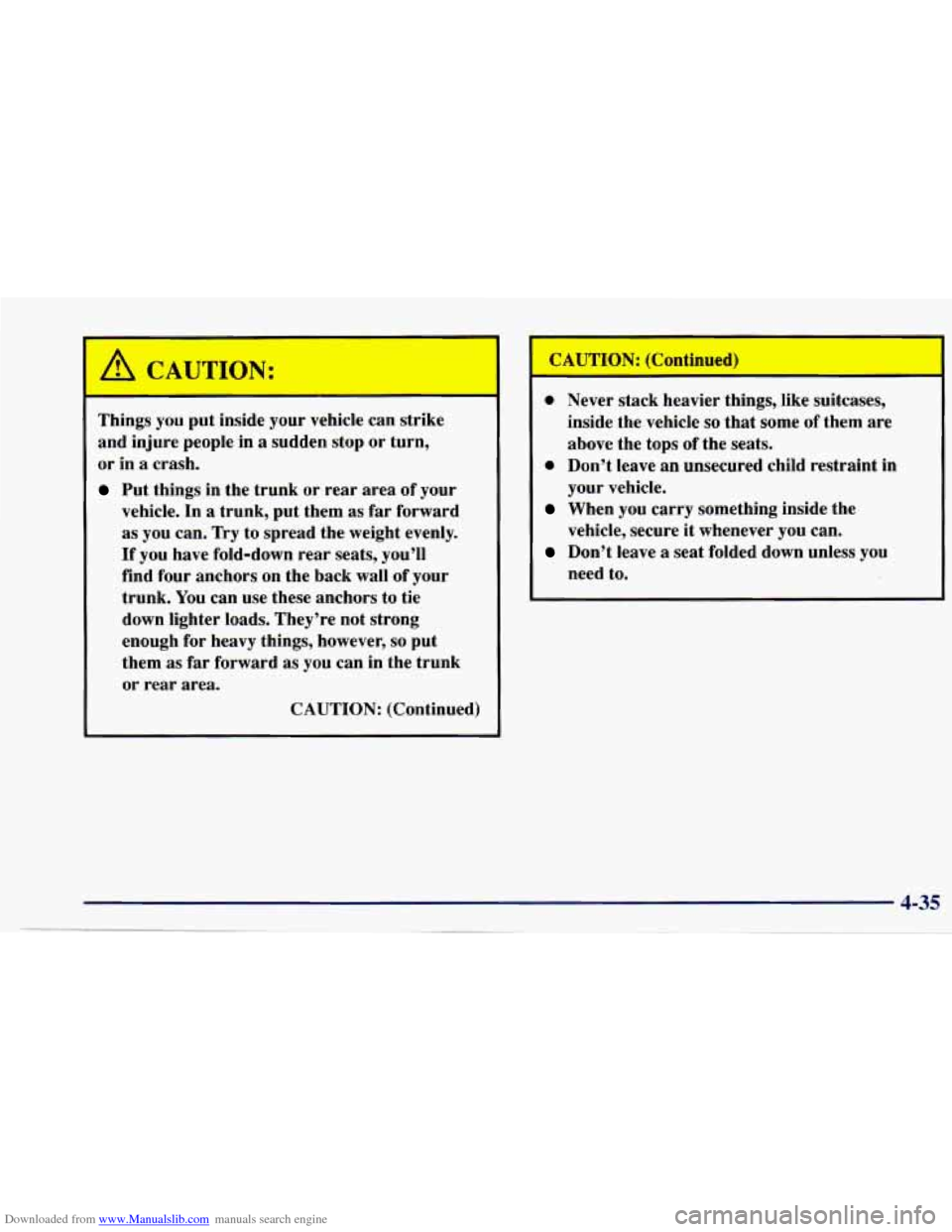
Downloaded from www.Manualslib.com manuals search engine /! CAUTION:
Things you put inside your vehicle can strike
and injure people in
a sudden stop or turn,
or in
a crash.
Put things in the trunk or rear area of your
vehicle. In
a trunk, put them as far forward
as you can. Try to spread the weight evenly.
If you have fold-down rear seats, you’ll
find four anchors on the back wall
of your
trunk.
You can use these anchors to tie
down lighter loads. They’re not strong
enough
for heavy things, however, so put
them
as far forward as you can in the trunk
or rear area.
CAUTION: (Continued) CAUTION: (Continued)
e Never stack heavier things, like suitcases,
inside the vehicle
so that some of them are
above the tops of the seats.
a Don’t leave an unsecured child restraint in
your vehicle.
When you carry something inside the
vehicle, secure it whenever you can.
Don’t leave a seat folded down unless you
need to.
Page 198 of 388
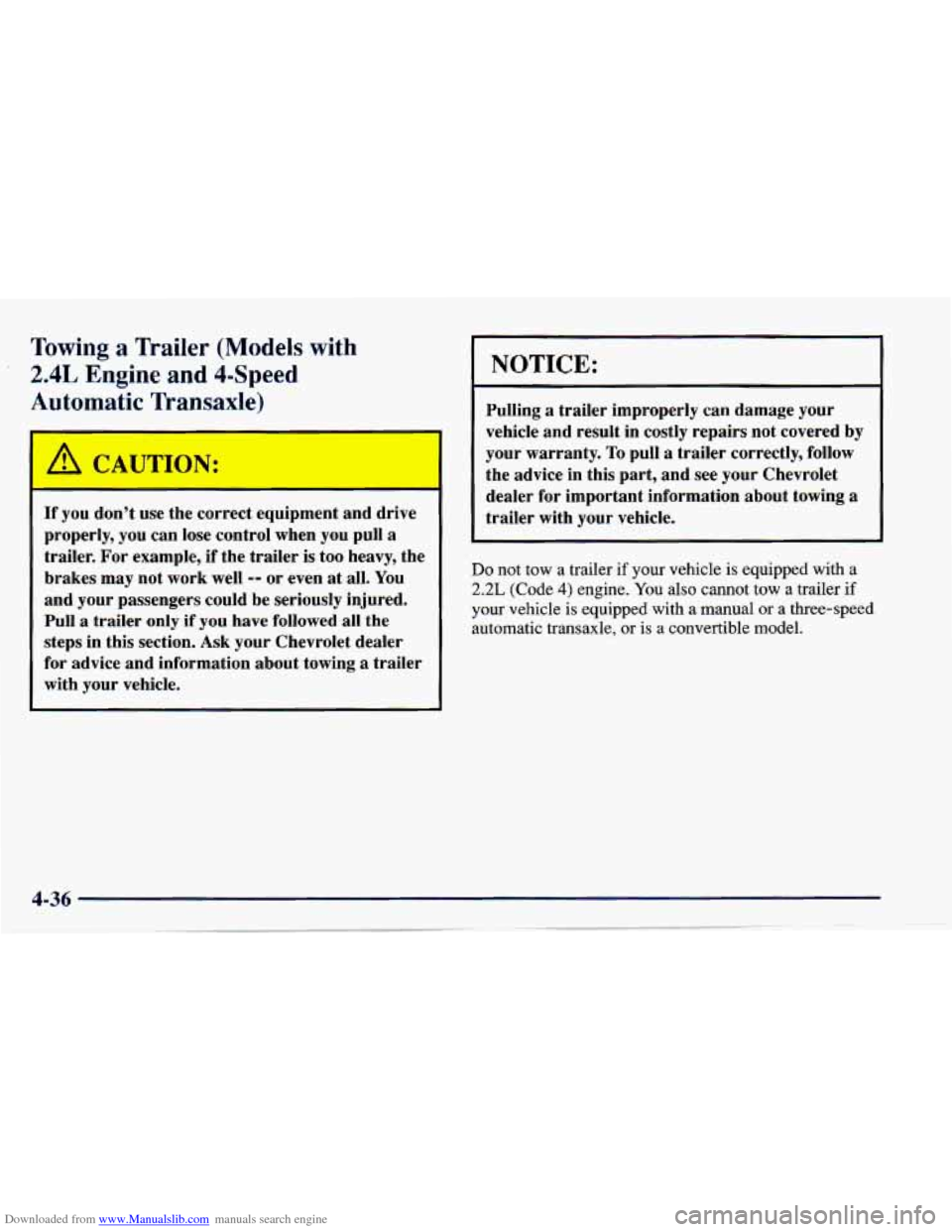
Downloaded from www.Manualslib.com manuals search engine Towing a Trailer (Models with
2.4L Engine and 4-Speed
Automatic Transaxle)
A CAUTION:
I
If you don’t use the correct equipment and drive
properly, you can lose control when you pull
a
trailer. For example, if the trailer is too heavy, the
brakes may not work well -- or even at all. You
and your passengers could be seriously injured.
Pull a trailer only if you have followed all the
steps in
this section. Ask your Chevrolet dealer
for advice and information about towing
a trailer
with your vehicle.
NOTICE:
Pulling a trailer improperly can damage your
vehicle and result in costly repairs not covered by
your warranty.
To pull a trailer correctly, follow
the advice in this part, and see your Chevrolet
dealer for important information about towing
a
trailer with your vehicle.
Do not tow a trailer if your vehicle is equipped with a
2.2L (Code 4) engine. You also cannot tow a trailer if
your vehicle is equipped with a manual or a three-speed
automatic transaxle, or is a convertible model.
Page 199 of 388
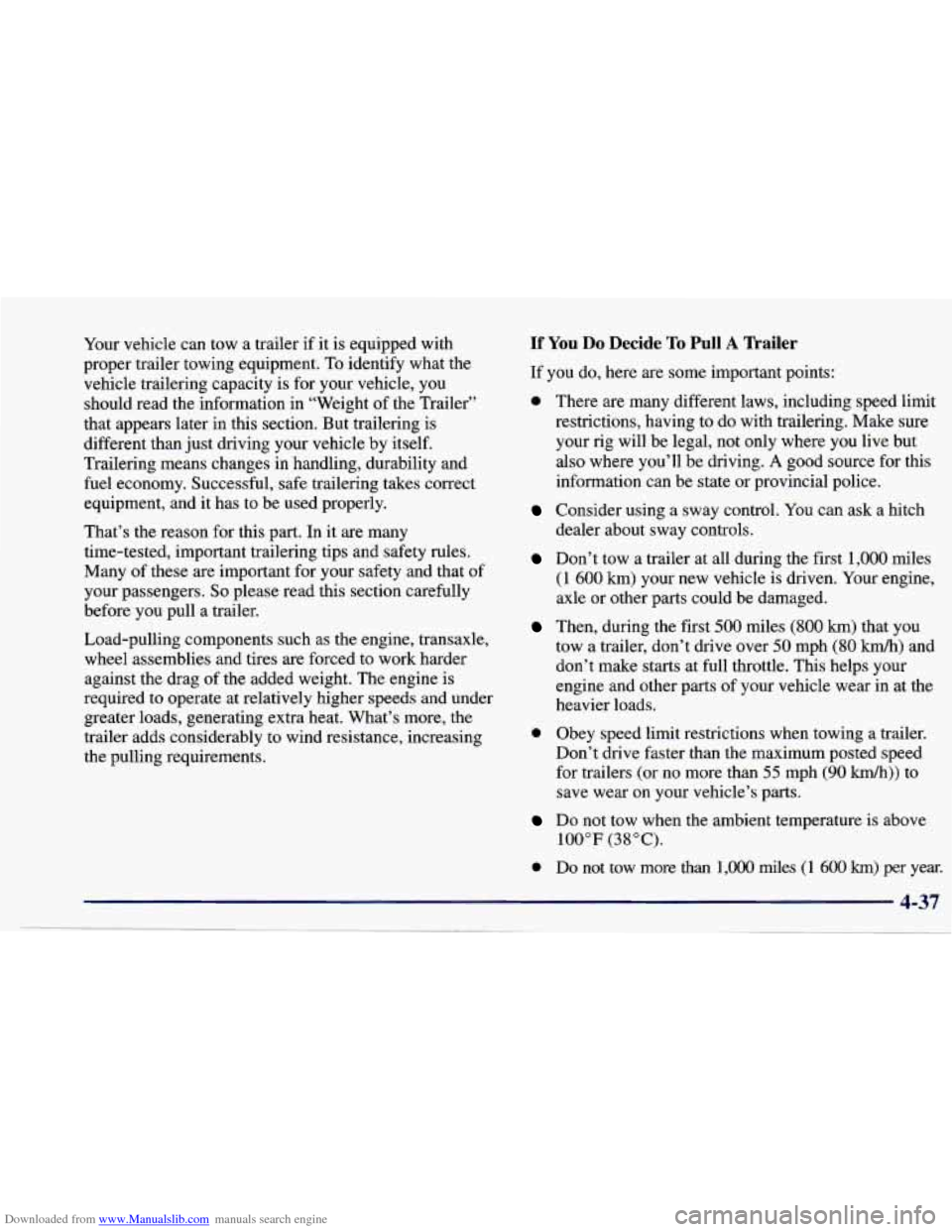
Downloaded from www.Manualslib.com manuals search engine Your vehicle can tow a trailer if it is equipped with
proper trailer towing equipment.
To identify what the
vehicle trailering capacity is for your vehicle, you
should read the information in “Weight of the Trailer”
that appears later in this section. But trailering is
different than just driving your vehicle by itself.
Trailering means changes in handling, durability and
fuel economy. Successful, safe trailering takes correct
equipment, and it has to be used properly.
That’s the reason for this part. In it are many
time-tested, important trailering tips and safety rules.
Many of these are important for your safety and that of
your passengers.
So please read this section carefully
before you pull a trailer.
Load-pulling components such
as the engine, transaxle,
wheel assemblies and tires are forced to work harder
against the drag of the added weight. The engine is
required to operate
at relatively higher speeds and under
greater loads, generating extra heat. What’s more, the
trailer adds considerably to wind resistance, increasing
the pulling requirements.
If You Do Decide To Pull A Trailer
If you do, here are some important points:
0 There are many different laws, including speed limit
restrictions, having to do with trailering. Make sure
your rig will be legal, not only where you live but
also where you’ll be driving.
A good source for this
information can be state or provincial police.
Consider using a sway control. You can ask a hitch
dealer about sway controls.
Don’t tow a trailer at all during the first 1,000 miles
(1 600 km) your new vehicle is driven. Your engine,
axle or other parts could be damaged.
Then, during the first 500 miles (800 km) that you
tow a trailer, don’t drive over
50 mph (80 km/h) and
don’t make starts at full throttle. This helps your
engine and other parts of your vehicle wear
in at the
heavier loads.
0 Obey speed limit restrictions when towing a trailer.
Don’t drive faster than the maximum posted speed
for trailers (or no more than
55 mph (90 km/h)) to
save wear on your vehicle’s parts.
Do not tow when the ambient temperature is above
100°F (38°C).
0 Do not tow more than 1,OOO miles (1 600 km) per year.
Page 200 of 388
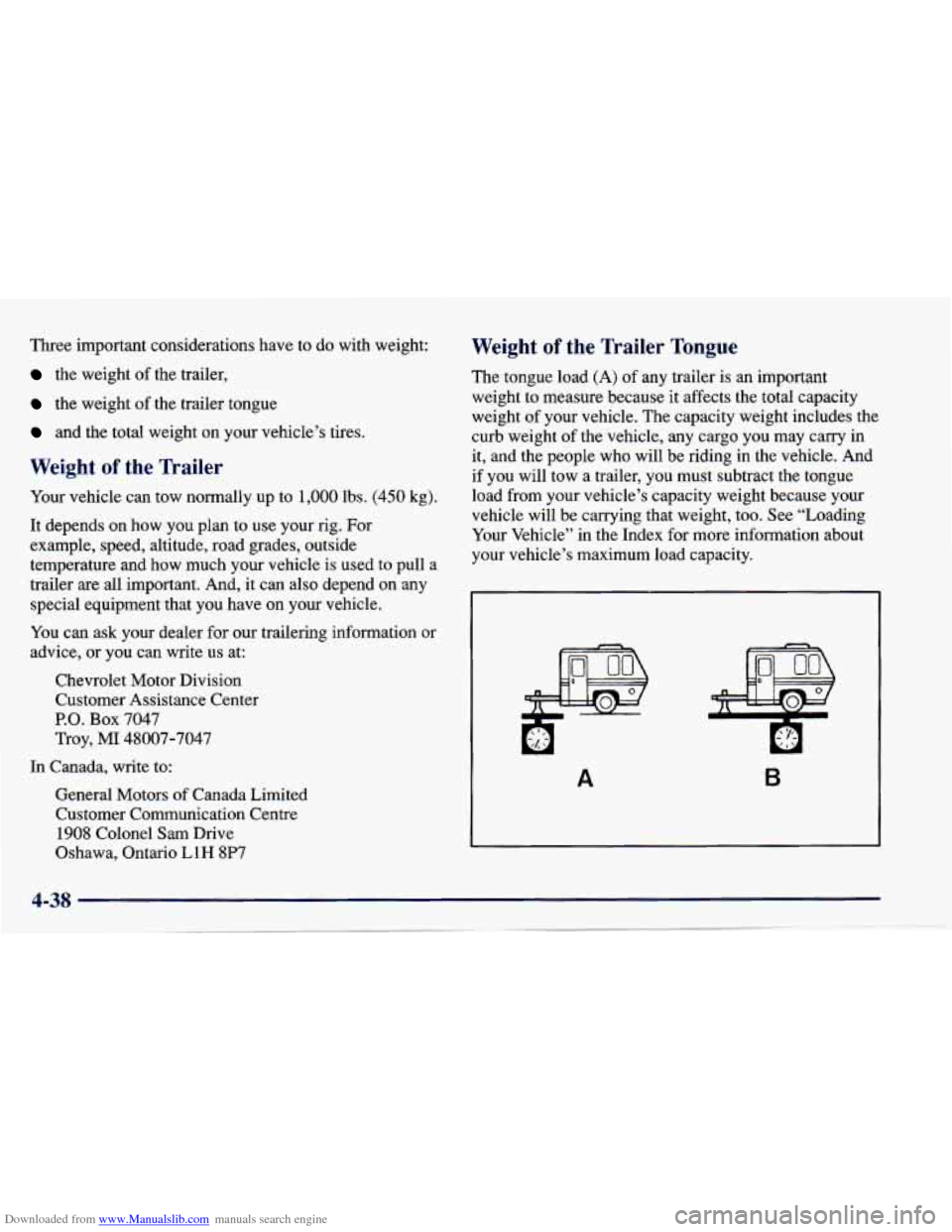
Downloaded from www.Manualslib.com manuals search engine Three important considerations have to do with weight:
the weight of the trailer,
the weight of the trailer tongue
and the total weight on your vehicle’s tires.
Weight of the Trailer
Your vehicle can tow normally up to 1,000 lbs. (450 kg).
It depends
on how you plan to use your rig. For
example, speed, altitude, road grades, outside
temperature and how much your vehicle is used to pull a
trailer are
all important. And, it can also depend on any
special equipment that you have on your vehicle.
You can ask your dealer for our trailering information
or
advice, or you can write us at:
Chevrolet Motor Division
Customer Assistance Center
P.O. Box 7047
Troy, MI 48007-7047
In Canada, write to:
General Motors of Canada Limited
Customer Communication Centre
1908 Colonel Sam Drive
Oshawa, Ontario
LlH 8P7
Weight of the Trailer Tongue
The tongue load (A) of any trailer is an important
weight to measure because it affects the total capacity
weight of your vehicle. The capacity weight includes the
curb weight of the vehicle, any cargo
you may carry in
it, and the people who will be riding in the vehicle. And
if you will tow a trailer, you must subtract the tongue
load from your vehicle’s capacity weight because your
vehicle will be carrying that weight, too. See “Loading
Your Vehicle” in the Index for more information about
your vehicle’s maximum load capacity.
L3
B